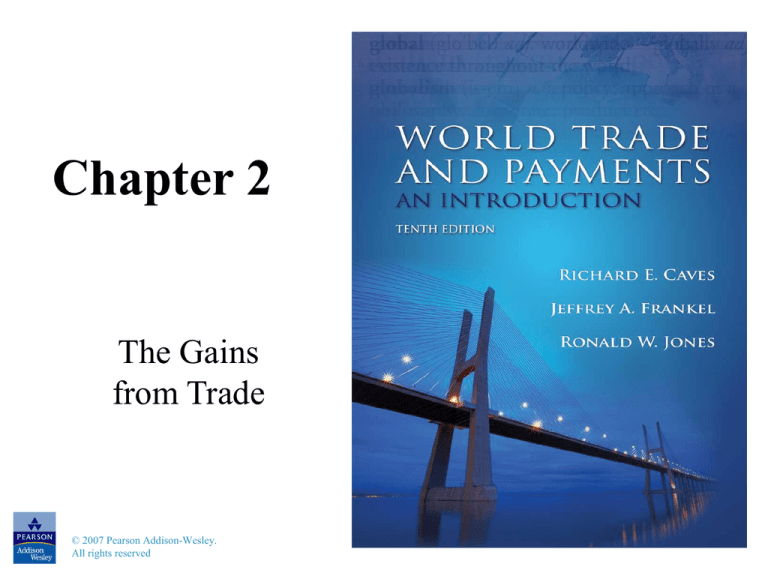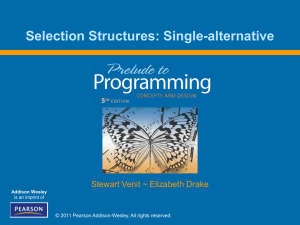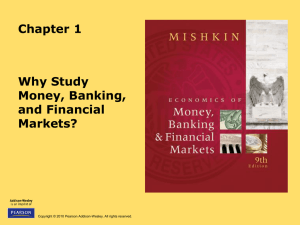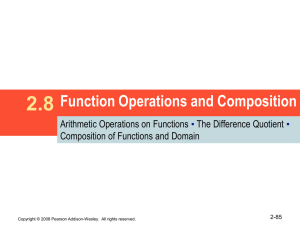
Chapter 2
The Gains
from Trade
© 2007 Pearson Addison-Wesley.
All rights reserved
Budget Constraint
• Demand of a single individual (representative).
• It can represent a country’s demand as well.
• Assumption: individuals spend exactly the
value of their income
• Trade balance assumption
• Budget constraint:
• Pc*C+ Pf*F=Income
• Relative price (absolute of slope)=Pc/Pf
Copyright © 2007 Pearson Addison-Wesley. All rights reserved.
2-2
Figure 2.1 The Budget Constraint
Copyright © 2007 Pearson Addison-Wesley. All rights reserved.
2-3
Indifference Curve
• Property of Indifference Curve:
–
–
–
–
ICs have negative slope
ICs cannot intersect
There are an infinite number of ICs
ICs are convex to the origin
• Marginal Rate of Substitution refers to the maximum amount
of y a consumer is willing to give up to get one more unit of x.
Copyright © 2007 Pearson Addison-Wesley. All rights reserved.
2-4
Indifference Curve
Copyright © 2007 Pearson Addison-Wesley. All rights reserved.
2-5
Figure 2.2 Indifference Curves
Copyright © 2007 Pearson Addison-Wesley. All rights reserved.
2-6
Production Possibility Frontier (PPF)
• Some points of production are beyond the current
capacity.
• PPF is negatively slope
• To produce more food, you need to sacrifice more
clothing
• PPF usually is bows-out, reflecting the so-called law
of increasing costs.
• Some exceptions exist
• A linear PPF
Copyright © 2007 Pearson Addison-Wesley. All rights reserved.
2-7
Figure 2.3 The Production Possibilities
Schedule
Copyright © 2007 Pearson Addison-Wesley. All rights reserved.
2-8
Production Possibilities (cont.)
International Trade, Dr. Miaojie Yu, Fall 2007Copyright © 2006 Pearson Addison-Wesley. All rights reserved.
Production Possibilities (cont.)
Copyright © 2007 Pearson Addison-Wesley. All rights reserved.
2-10
Figure 2.4 Transformation Schedules:
Special Cases
Copyright © 2007 Pearson Addison-Wesley. All rights reserved.
2-11
Fixed Allocation of Resources
•
•
•
•
Full employment is found at point E.
Even if prices change, outputs do not.
Supply curve is vertical
It reflects fixed production
Copyright © 2007 Pearson Addison-Wesley. All rights reserved.
2-12
Gains from Trade
• Autarky case: E point
• Remember the relative price is Pc/Pf
• It rotates from AB to CD when food is
relatively cheaper.
• Curve CD is only possible in trade
• Gains from Trade (indifference curve) y0 up to
y1
Copyright © 2007 Pearson Addison-Wesley. All rights reserved.
2-13
Figure 2.5 The Trade Triangle for
the Home Country
Copyright © 2007 Pearson Addison-Wesley. All rights reserved.
2-14
Gains from Trade
• The opportunity to trade at relative prices different
from those in isolation at home must improve real
incomes at home.
• Real income is denoted by IC level.
• Trade Triangle
• A divergence in the relative price of goods in the two
countries before trade indicates a mutual potential
gain from trade for both countries at a common
intermediate price ratio.
Copyright © 2007 Pearson Addison-Wesley. All rights reserved.
2-15
Figure 2.6 The Trade Triangle for
the Foreign Country
Copyright © 2007 Pearson Addison-Wesley. All rights reserved.
2-16
Gains from Trade with Resource Reallocation
• With free-trade prices shown by the slope of
line 2, production at home takes place at A and
consumption at B.
• BDA is the trade triangle.
• The country exports DA units of clothing in
exchange for imports of BD units of food.
• Autarky: E point, price line 1.
Copyright © 2007 Pearson Addison-Wesley. All rights reserved.
2-17
Figure 2.7 The Trade
Triangle in the
Home Country
Copyright © 2007 Pearson Addison-Wesley. All rights reserved.
2-18
Gains from Trade with Resource Reallocation
• The slope of line 2 is the same as in the previous
figure.
• Trade is balanced as the foreign country’s trade
triangle (ADB)*, matches the home country’s triangle
BDA in the previous figure.
Copyright © 2007 Pearson Addison-Wesley. All rights reserved.
2-19
Figure 2.8
The Trade
Triangle in the
Foreign Country
Copyright © 2007 Pearson Addison-Wesley. All rights reserved.
2-20
Equations of Exchange Equilibrium
• For each country, value of aggregate demand equals value of
production
• Assume home imports food, foreign imports clothes:
• Denote relative price as p=pf/pc.
• Assume no tariffs, price is identical across countries.
Copyright © 2007 Pearson Addison-Wesley. All rights reserved.
2-21
Equations of Exchange Equilibrium
• Suppose home’s excess demand=foreign excess supply
• Free trade equilibrium is denoted as: world demand and world
supply are equal
• The value of the home’s imports equal the value of the
foreign ’s import
Copyright © 2007 Pearson Addison-Wesley. All rights reserved.
2-22
Comparative Advantages
• A country has a comparative advantage in a good if,
in autarky, that good is relatively cheaper than in
other country.
• Doctrine of comparative costs: a country gains from
international trade by exporting the commodity in
which its costs are comparatively lower than in the
other country.
Copyright © 2007 Pearson Addison-Wesley. All rights reserved.
2-23
Comparative Advantage
• The pair of relative supply curves shows the production bias in
favor of the foreign country possessing a comparative
advantage in producing food.
• From point t: Foreign Food; Home Clothing
• Vertical looking: the relative cost of producing food abroad, at
A*, would be lower than point A.
• Remember the supply curve is the cost curve.
Copyright © 2007 Pearson Addison-Wesley. All rights reserved.
2-24
Figure 2.9 Comparative Advantage
Copyright © 2007 Pearson Addison-Wesley. All rights reserved.
2-25
Winners and Losers: Autarky to Free Trade
• International trade can hurt somebody.
• The individual is a net seller of food at home in
autarky (EA), with home prices shown by line 1.
With food relatively cheaper on world markets (line
2), the individual’s consumption is reduced from G to
H.
• So he gets hurt from trade.
• Some gain but some lose
Copyright © 2007 Pearson Addison-Wesley. All rights reserved.
2-26
Figure 2.10 International Trade Can
Hurt
Copyright © 2007 Pearson Addison-Wesley. All rights reserved.
2-27
Figure 2.A.1 The Box Diagram
and the Contract Curve
Copyright © 2007 Pearson Addison-Wesley. All rights reserved.
2-28
Box Diagram
• Point E (E*) shows the original endowment allocation.
• Indifference curve: consumption bundle A is indifferent to
bundle E.
• Similarly, A* indifferent to E*
• CC’ curve is the contract curve, which is the locus of all
points where and indifference curve of the home is tangent to
an indifference curve of the foreign country.
• Any shaded area represents an improvement in welfare for
both.
• Q represents free-trade equilibrium.
• Free trade leads to a world consumption point where marginal
rate of substitution in each country equal a common price
ratio.
Copyright © 2007 Pearson Addison-Wesley. All rights reserved.
2-29
Box Diagram
• Any deviation from free trade must harm some
country.
• Any deviation away from the contract curve
must be worse than the point on the contract
curve.
Copyright © 2007 Pearson Addison-Wesley. All rights reserved.
2-30
Figure 2.B.1 Substitution and Income
Effects
Copyright © 2007 Pearson Addison-Wesley. All rights reserved.
2-31
Substitution and Income Effects
• With E the production point, consumption is initially at A at
term of trade shown by line 1.
• A fall in food’s import price is line 3.
• The substitution effect is the move from A to C along the
initial indifference curve. It denotes the change in demand if
consumption is restricted to the same indifference curve.
• The income effect is the move from C to B.
• A fall in import prices raises real income.
• It shows how such an increase in real income at constant price
spills into increased demand for both commodities.
Copyright © 2007 Pearson Addison-Wesley. All rights reserved.
2-32
Offer Curves
• Many diagrams discuss relationship between price and
quantity.
• Offer curve talks about export and import.
• Since quantities are shown along the axes, relative price are
the slopes of the rays from the origin.
• Slope of OA=Pc/Pf.
• Mf=(Pc/Pf)*Xc
• Free-trade equilibrium is shown by point Q, with the
equilibrium terms of trade equal to the slope of ray OQ.
Copyright © 2007 Pearson Addison-Wesley. All rights reserved.
2-33
Figure 2.C.1 Offer Curves
Copyright © 2007 Pearson Addison-Wesley. All rights reserved.
2-34








